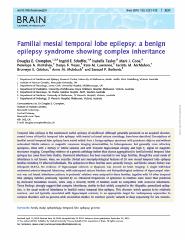Please use this identifier to cite or link to this item:
https://ahro.austin.org.au/austinjspui/handle/1/11117| Title: | Familial mesial temporal lobe epilepsy: a benign epilepsy syndrome showing complex inheritance. | Austin Authors: | Crompton, Douglas E;Scheffer, Ingrid E ;Taylor, Isabella;Cook, Mark J;McKelvie, Penelope A;Vears, Danya F;Lawrence, Kate M;McMahon, Jacinta M;Grinton, Bronwyn E;McIntosh, Anne M ;Berkovic, Samuel F | Affiliation: | douglas.crompton@ncl.ac.uk Department of Medicine and Epilepsy Research Centre, University of Melbourne, Austin Health, West Heidelberg, Victoria, Australia |
Issue Date: | 23-Sep-2010 | Publication information: | Brain : A Journal of Neurology 2010; 133(11): 3221-31 | Abstract: | Temporal lobe epilepsy is the commonest partial epilepsy of adulthood. Although generally perceived as an acquired disorder, several forms of familial temporal lobe epilepsy, with mesial or lateral seizure semiology, have been described. Descriptions of familial mesial temporal lobe epilepsy have varied widely from a benign epilepsy syndrome with prominent déjà vu and without antecedent febrile seizures or magnetic resonance imaging abnormalities, to heterogeneous, but generally more refractory epilepsies, often with a history of febrile seizures and with frequent hippocampal atrophy and high T₂ signal on magnetic resonance imaging. Compelling evidence of a genetic aetiology (rather than chance aggregation) in familial mesial temporal lobe epilepsy has come from twin studies. Dominant inheritance has been reported in two large families, though the usual mode of inheritance is not known. Here, we describe clinical and neurophysiological features of 20 new mesial temporal lobe epilepsy families including 51 affected individuals. The epilepsies in these families were generally benign, and febrile seizure history was infrequent (9.8%). No evidence of hippocampal sclerosis or dysplasia was present on brain imaging. A single individual underwent anterior temporal lobectomy, with subsequent seizure freedom and histopathological evidence of hippocampal sclerosis was not found. Inheritance patterns in probands' relatives were analysed in these families, together with 19 other temporal lobe epilepsy families previously reported by us. Observed frequencies of epilepsies in relatives were lower than predicted by dominant Mendelian models, while only a minority (8/39) of families could be compatible with recessive inheritance. These findings strongly suggest that complex inheritance, similar to that widely accepted in the idiopathic generalized epilepsies, is the usual mode of inheritance in familial mesial temporal lobe epilepsy. This disorder, which appears to be relatively common, and not typically associated with hippocampal sclerosis, is an appropriate target for contemporary approaches to complex disorders such as genome-wide association studies for common genetic variants or deep sequencing for rare variants. | Gov't Doc #: | 20864493 | URI: | https://ahro.austin.org.au/austinjspui/handle/1/11117 | DOI: | 10.1093/brain/awq251 | Journal: | Brain | URL: | https://pubmed.ncbi.nlm.nih.gov/20864493 | Type: | Journal Article | Subjects: | Adolescent Adult Child Child, Preschool Diseases in Twins.genetics Epilepsy, Complex Partial.diagnosis.genetics.physiopathology Epilepsy, Temporal Lobe.diagnosis.genetics.physiopathology Female Humans Inheritance Patterns.genetics Male Middle Aged Pedigree Syndrome Young Adult |
| Appears in Collections: | Journal articles |
Files in This Item:
| File | Description | Size | Format | |
|---|---|---|---|---|
| 20864493.pdf | 737.94 kB | Adobe PDF |  View/Open |
Page view(s)
78
checked on Feb 11, 2025
Download(s)
154
checked on Feb 11, 2025
Google ScholarTM
Check
Items in AHRO are protected by copyright, with all rights reserved, unless otherwise indicated.
